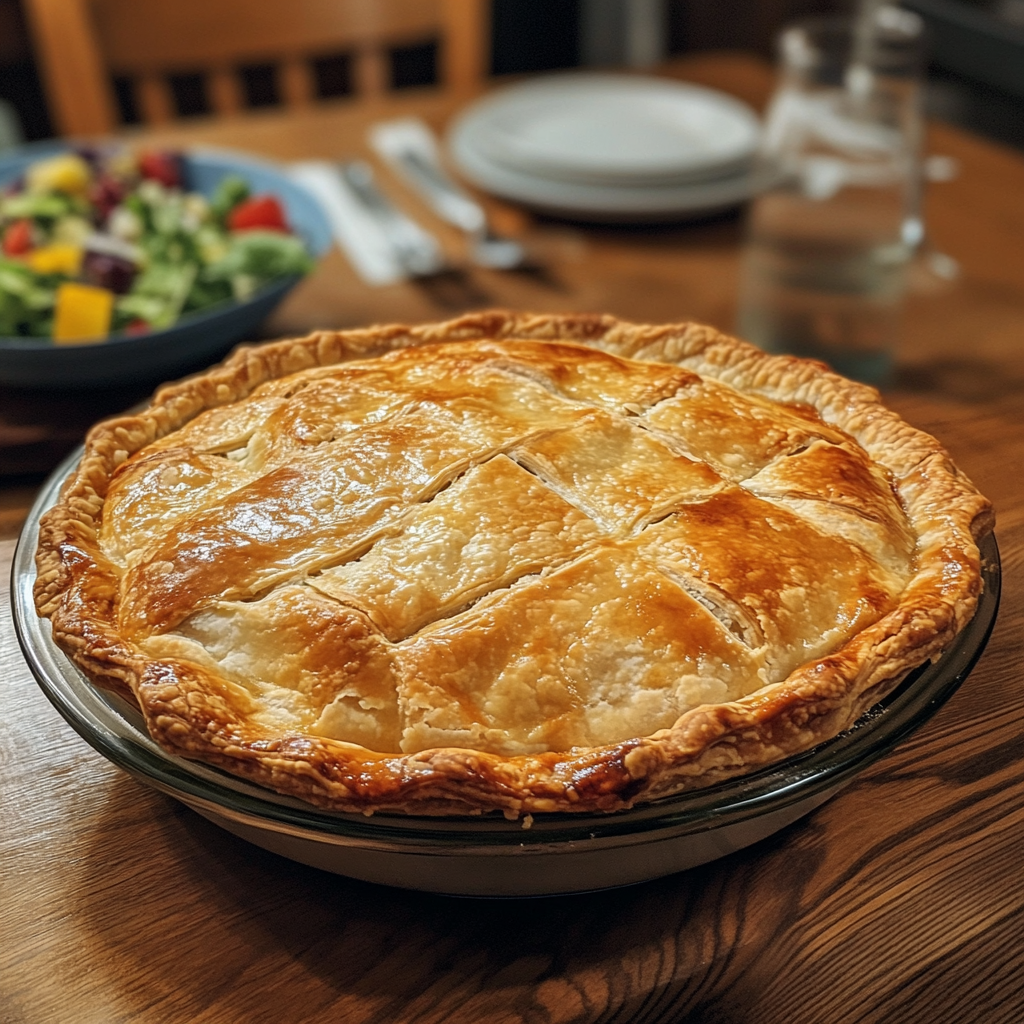Introduction
What is Chicken Pot Pie?
Chicken pot pie is a savory dish that combines a rich, creamy filling made from chicken, vegetables, and a luscious sauce. All enveloped in a flaky, golden crust. This hearty, comforting classic has earned a place on dinner tables worldwide. Providing warmth and satisfaction in every bite. While its ingredients are simple, the result is a masterpiece that appeals to all ages.
A Brief History of Chicken Pot Pie
The origins of chicken pot pie can be traced back to ancient Greece and Rome. Where early versions of savory pies were crafted using a variety of fillings. These early iterations spread throughout Europe, evolving over centuries. By the time pot pies reached America, they had become a beloved staple, with chicken emerging as a popular choice of protein due to its availability and versatility.
In colonial times, chicken pot pie was seen as both practical and indulgent, a dish that combined accessible ingredients with a sense of culinary creativity. Modern adaptations honor its history while allowing cooks to tailor it to their tastes and dietary needs.
Why is it a Comfort Food Classic
There’s a reason why chicken pot pie holds a special place in the hearts of many. It’s the perfect meal for cozy evenings, family gatherings, or a comforting pick-me-up on cold days. The harmony of textures—creamy filling paired with a crispy crust—makes it a dish that feels both indulgent and wholesome. Additionally, its customizable nature ensures that everyone can enjoy it, whether you’re a fan of traditional recipes or creative twists.
Ingredients for the Perfect Recipe
Essential Ingredients for a Classic Recipe
Crafting a chicken pot pie starts with a few staple ingredients that bring its comforting flavors to life. Here’s what you’ll need:
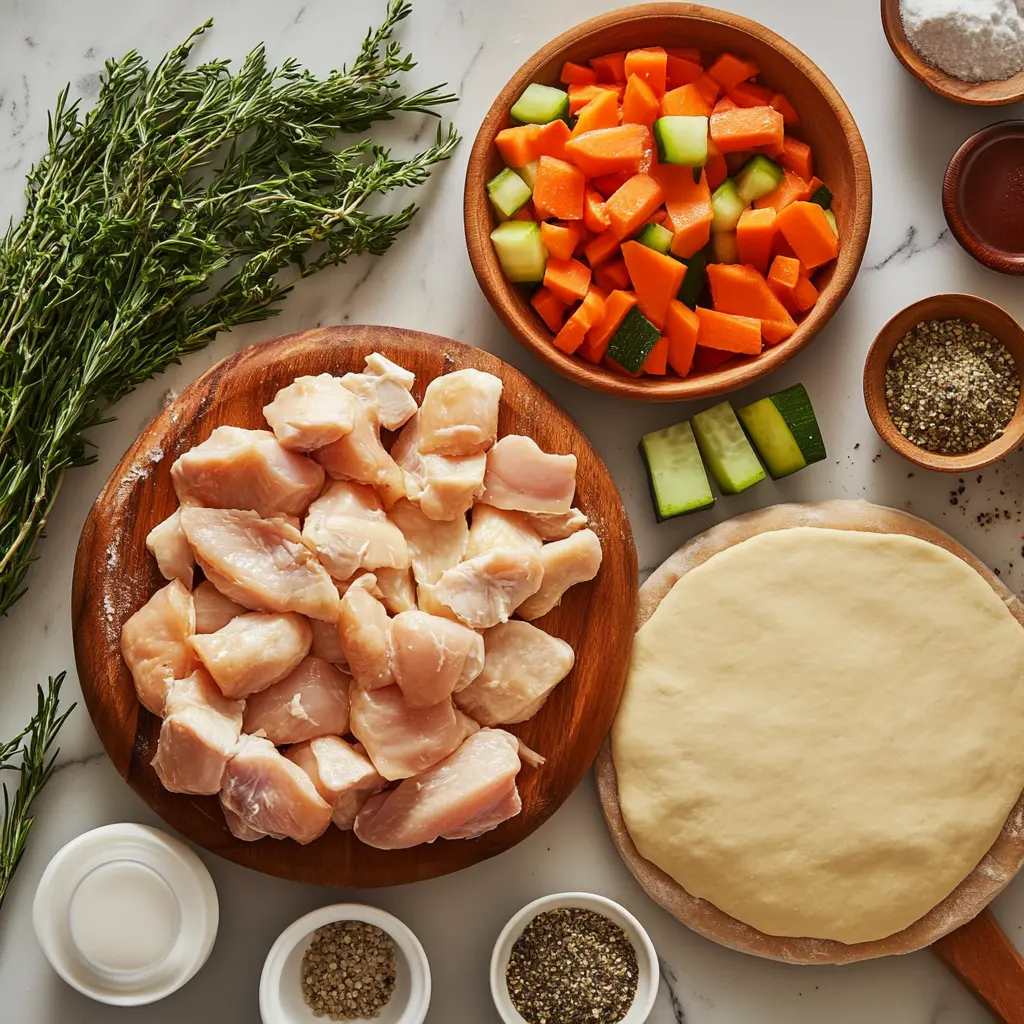
- Chicken
The star of the dish, chicken provides a tender and flavorful protein base. Opt for cooked and shredded chicken breast or thighs for the best texture and taste. - Vegetables
A classic medley includes carrots, peas, celery, and onions. These add both flavor and a pop of color, creating a visually appealing and nutritious filling. - Creamy Sauce
A luscious sauce made from butter, flour, chicken broth, and milk (or heavy cream) forms the backbone of the dish. This velvety mixture binds the chicken and vegetables together. - Pie Crust
A flaky, buttery crust is essential for the perfect pot pie. You’ll need one crust for the base and another to seal the filling. Store-bought crusts are convenient, but homemade crusts elevate the dish. - Seasonings
Salt, pepper, garlic powder, and dried herbs like thyme or parsley are vital for enhancing the overall flavor of the pot pie.
Alternative Ingredients for Special Diets
Chicken pot pie can be easily adapted for various dietary needs without compromising flavor:
- Vegetarian Options
- Replace chicken with hearty vegetables like mushrooms, sweet potatoes, or squash.
- Use vegetable broth in place of chicken broth.
- Gluten-Free Options
- Swap traditional pie crusts for gluten-free versions made from almond or coconut flour.
- Use cornstarch or gluten-free flour to thicken the sauce.
- Dairy-Free Options
- Substitute regular milk or cream with almond milk, coconut milk, or soy milk.
- Use a vegan butter alternative to make the sauce.
Tips for Choosing Fresh and Quality Ingredients
- Chicken
- Opt for organic or free-range chicken for a richer flavor.
- Rotisserie chicken is a convenient and flavorful option.
- Vegetables
- Fresh vegetables are ideal, but frozen or canned options work well in a pinch. Just ensure they’re fully drained and thawed.
- Broth and Dairy
- Use homemade chicken broth for maximum flavor, or select a low-sodium store-bought version to control salt levels.
- Whole milk or heavy cream adds a luxurious texture to the sauce.
- Pie Crusts
- When making crusts from scratch, use chilled butter and ice-cold water for the flakiest results.
- If using store-bought crusts, look for high-quality, all-butter varieties for better flavor.
Step-by-Step Guide for the Recipe
Preparing the Chicken and Vegetables
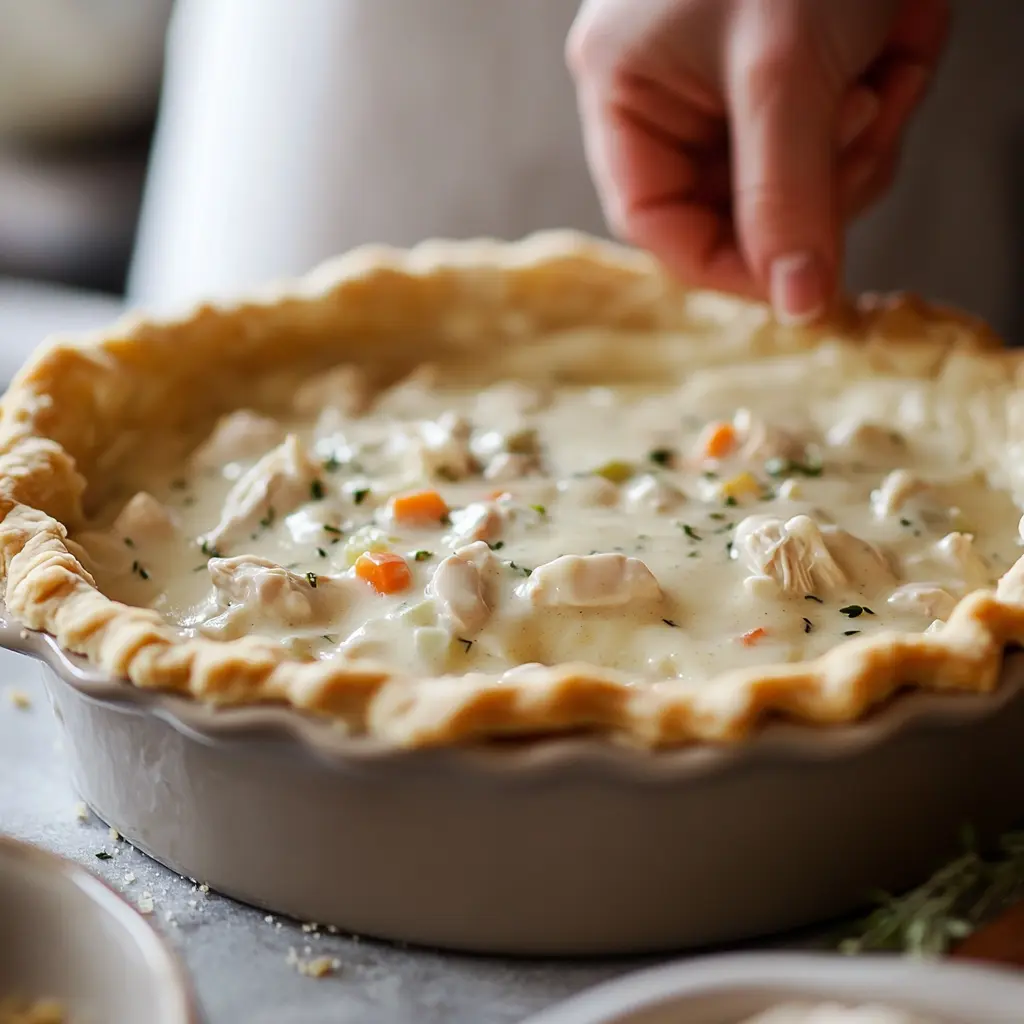
- Cook the Chicken
- Begin by cooking your chicken. Poach, bake, or pan-sear chicken breasts or thighs until fully cooked (internal temperature of 165°F or 74°C).
- Shred or dice the chicken into bite-sized pieces. Rotisserie chicken is a quick and flavorful alternative.
- Prepare the Vegetables
- Dice fresh carrots, celery, and onions into small, uniform pieces for even cooking.
- If using fresh peas, blanch them briefly in boiling water. Frozen peas can be added directly to the filling.
- Sauté the vegetables (except peas) in a large skillet with butter until they soften slightly, enhancing their flavor.
Crafting the Perfect Sauce
- Start with a Roux
- In the same skillet, melt 4 tablespoons of butter over medium heat. Once melted, add 4 tablespoons of all-purpose flour.
- Whisk constantly for 1-2 minutes to cook out the raw flour taste.
- Add Liquids Gradually
- Slowly pour in 2 cups of chicken broth, whisking continuously to prevent lumps.
- Stir in 1 cup of milk or heavy cream to create a rich and creamy texture.
- Season the Sauce
- Add salt, pepper, garlic powder, and dried thyme or parsley to taste.
- Let the sauce simmer for 3-5 minutes until thickened, then remove from heat.
Assembling the Pot Pie
- Combine the Filling
- In a large mixing bowl, combine the shredded chicken, sautéed vegetables, and creamy sauce.
- Stir gently until all ingredients are evenly coated with the sauce.
- Prepare the Pie Crust
- Roll out one pie crust to line a 9-inch pie dish. Press it gently into the dish, leaving a slight overhang around the edges.
- Spoon the chicken and vegetable filling into the crust, spreading it evenly.
- Top with the Second Crust
- Roll out the second pie crust and lay it over the filling. Trim any excess dough and pinch the edges to seal the pie.
- Use a fork or your fingers to crimp the edges for a decorative finish.
- Cut small slits in the top crust to allow steam to escape during baking.
Baking Tips for a Golden Crust
- Egg Wash for Shine
- Brush the top crust with a mixture of beaten egg and a tablespoon of water for a glossy, golden-brown finish.
- Bake to Perfection
- Preheat your oven to 400°F (200°C). Place the assembled pie on the center rack and bake for 30-35 minutes, or until the crust is golden brown and the filling is bubbling.
- Cooling and Serving
- Allow the pie to cool for 5-10 minutes before slicing. This helps the filling set and makes serving easier.
Variations
Classic Chicken Pot Pie Recipe
The traditional chicken pot pie remains a favorite for its timeless appeal. It features the classic combination of tender chicken, a medley of carrots, peas, celery, and onions, all enveloped in a creamy sauce. This version uses a buttery double crust, delivering the perfect balance between flaky pastry and hearty filling. For an authentic touch, prepare the crust from scratch and season generously with herbs like thyme and parsley.
Individual Pot Pies
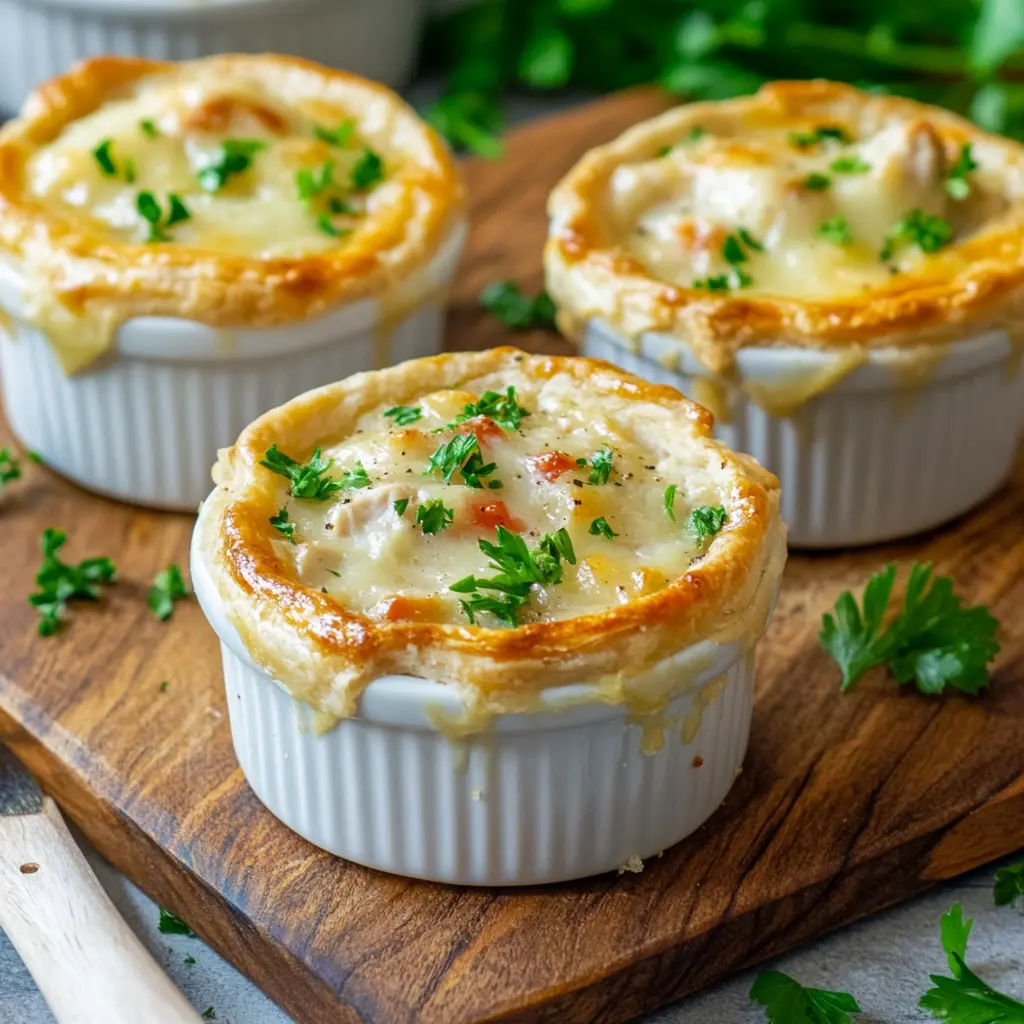
For a personalized and elegant twist, consider making individual chicken pot pies. Using ramekins or small oven-safe bowls, you can portion the filling and top each with its own crust. This approach is perfect for dinner parties, as it allows each guest to enjoy their own pie. Plus, the smaller size reduces baking time—typically about 20-25 minutes at 400°F (200°C).
Skillet
This version eliminates the need for a traditional pie dish and simplifies preparation. Cook the filling directly in a large, oven-safe skillet, then top it with a single layer of pie crust, puff pastry, or even biscuit dough. The result is a rustic, family-style dish that’s just as flavorful as the original, with a slightly crispy topping that complements the creamy interior.
Crustless
For a lighter option, skip the crust entirely and focus on the filling. This variation works wonderfully for those watching their carb intake or simply looking for a quicker meal. Serve the creamy chicken and vegetable mixture on its own, or pair it with a side of mashed potatoes or cauliflower for a complete meal. You can also bake the filling in a casserole dish topped with breadcrumbs or shredded cheese for added texture.
Creative Add-Ons and Flavors
- Cheddar Chicken Pot Pie
Add shredded cheddar cheese to the sauce or sprinkle it on top of the crust for a rich, cheesy variation. - Southwest Chicken Pot Pie
Incorporate corn, black beans, and a touch of chili powder or cumin for a Southwestern-inspired version. Serve with a dollop of sour cream. - Seafood Pot Pie
Replace chicken with shrimp, crab, or a combination of seafood for a coastal twist. Pair with a creamy, lemon-infused sauce. - Breakfast Pot Pie
Swap chicken for breakfast sausage or bacon and include scrambled eggs in the filling. Use biscuit dough for the crust to create a unique breakfast dish.
Serving and Pairing
Best Side Dishes to Complement Chicken Pot Pie
While chicken pot pie is a satisfying meal on its own, pairing it with the right side dishes can elevate your dining experience. Here are some excellent options:
- Fresh Green Salad
- A light, refreshing salad with mixed greens, cherry tomatoes, cucumbers, and a tangy vinaigrette balances the richness of the pot pie.
- Roasted Vegetables
- Serve a medley of roasted asparagus, broccoli, or Brussels sprouts seasoned with olive oil, garlic, and a pinch of salt. The crispy texture contrasts beautifully with the creamy pot pie filling.
- Mashed Potatoes
- For an extra-comforting meal, pair your pot pie with creamy mashed potatoes. Flavored with butter and a hint of garlic, they complement the savory filling.
- Bread or Rolls
- Warm, crusty bread or soft dinner rolls make excellent accompaniments, allowing diners to soak up every bit of the delicious filling.
- Pickled Vegetables
- The acidity of pickled vegetables, such as beets or cucumbers, provides a bright counterpoint to the rich flavors of the pot pie.
Presentation Tips for a Feast-Worthy Meal
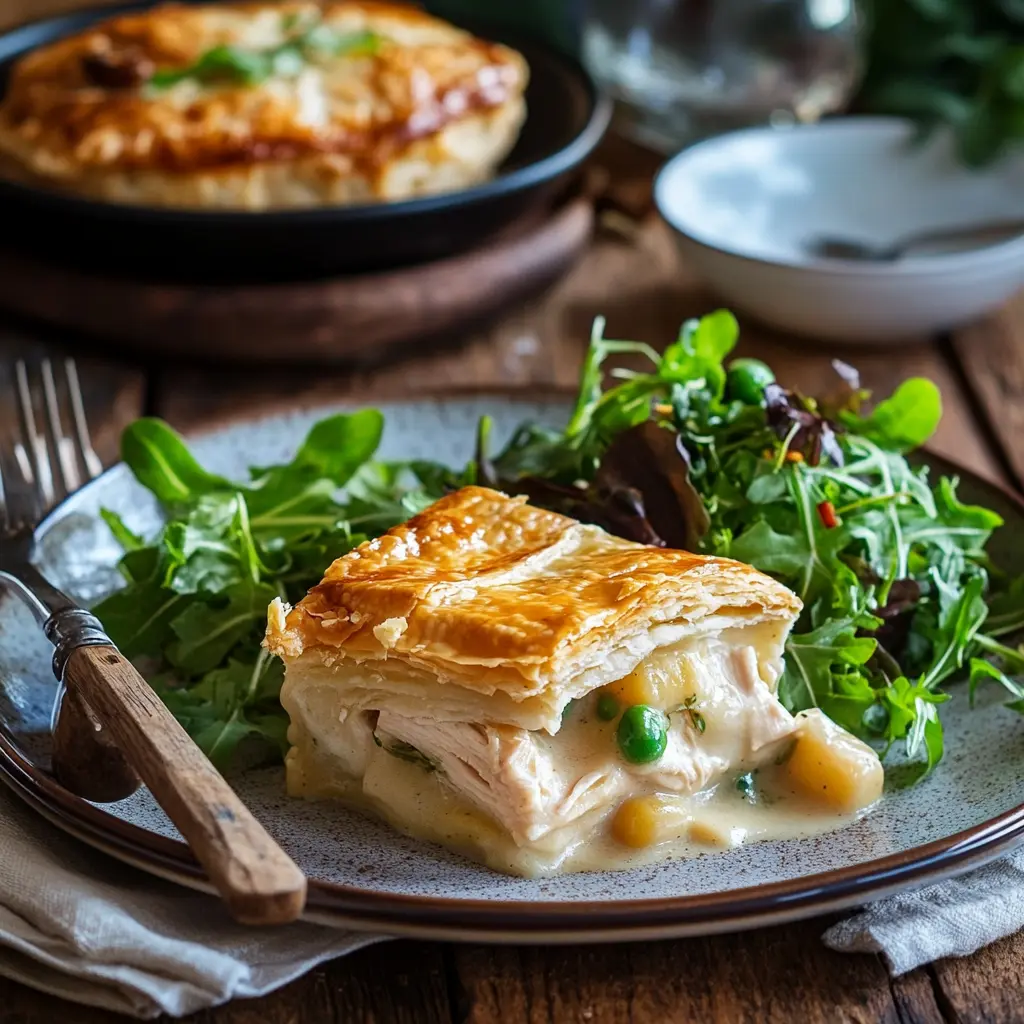
- Individual Servings
- Slice the chicken pot pie into neat wedges or portions, ensuring each plate has a perfect balance of crust and filling. Add a garnish of fresh parsley for a pop of color.
- Family-Style Dining
- For a more rustic approach, serve the pot pie directly from the baking dish or skillet. Place it at the center of the table and let everyone help themselves.
- Creative Plating
- For an elevated presentation, use ring molds to serve neatly stacked portions of pot pie, accompanied by small bowls of side dishes.
- Beverage Pairings
- Pair your meal with complementary drinks like a crisp white wine (Chardonnay or Sauvignon Blanc), a light beer, or a sparkling apple cider for a family-friendly option.
Tips for Reheating and Serving Leftovers
- Reheating in the Oven
- Preheat your oven to 350°F (175°C). Place the pot pie on a baking sheet and cover it with aluminum foil to prevent the crust from overbrowning. Heat for 20-30 minutes or until warmed through.
- Microwave Option
- If reheating individual portions, use a microwave-safe plate and cover the pie loosely with a damp paper towel to keep it moist. Heat in 1-minute intervals until warm.
- Freezing Leftovers
- Store leftover pot pie in an airtight container or wrap it tightly in foil. Freeze for up to three months. Thaw overnight in the refrigerator before reheating.
Common Mistakes to Avoid When Making Chicken Pot Pie
1. Over or Undercooking the Filling
One of the most frequent issues is ending up with a filling that’s too dry or overly soupy. Achieving the right consistency is key to a perfect chicken pot pie.
- Avoid Overcooking Vegetables
When sautéing vegetables, cook them until just tender. They will finish cooking while the pie bakes, preventing them from turning mushy. - Monitor Sauce Thickness
The sauce should be thick but not overly stiff. A too-thin sauce will seep into the crust, making it soggy, while an overly thick sauce can result in a dry filling. Aim for a consistency similar to gravy.
2. Soggy Crust Troubleshooting
A soggy crust is a common complaint when baking pot pies, but there are ways to ensure a crisp, golden crust every time.
- Blind Bake the Bottom Crust
For a sturdier base, partially bake the bottom crust before adding the filling. Line it with parchment paper, fill with pie weights or dried beans, and bake for 10 minutes at 375°F (190°C). - Prevent Sauce Seepage
Allow the filling to cool slightly before pouring it into the crust. This prevents the heat from softening the bottom crust prematurely. - Choose the Right Baking Dish
A metal or ceramic pie dish conducts heat better than glass, promoting even cooking and a crisp crust.
3. Preventing a Bland Flavor
The filling’s flavor can make or break your chicken pot pie. Under-seasoning is a common mistake but is easy to fix with the right approach.
- Season in Layers
Season each component of the dish, from the chicken to the vegetables and the sauce. Herbs like thyme, parsley, and a dash of nutmeg enhance the filling’s depth. - Taste Test
Always taste the sauce before assembling the pie. Adjust salt, pepper, and other seasonings as needed to ensure a flavorful result.
4. Overbaking or Underbaking the Pie
Timing is crucial for achieving a perfect crust and evenly cooked filling.
- Follow Baking Times Closely
Bake the pie at the recommended temperature (usually 375°F to 400°F) and monitor it closely during the last 10 minutes. - Shield the Edges
To prevent the crust edges from burning, cover them with aluminum foil or a pie shield after 15-20 minutes of baking.
5. Using the Wrong Type of Crust
The crust is a vital part of the dish, and selecting the wrong type can compromise the final result.
- Stick to Buttery Crusts
All-butter crusts or those with a mix of butter and shortening provide the best balance of flavor and texture. Avoid overly processed, pre-made crusts that lack flakiness. - Experiment with Puff Pastry
For an extra crispy and flaky topping, consider using puff pastry. Just ensure it’s properly thawed and vented before baking.
6. Not Venting the Top Crust
Failing to create steam vents in the top crust can lead to uneven baking and a soggy interior. Use a sharp knife to cut small slits or decorative shapes to allow steam to escape during baking.
7. Rushing the Cooling Process
While it’s tempting to dig into your chicken pot pie right out of the oven, letting it cool for at least 5-10 minutes is essential. This resting period allows the filling to set, making it easier to slice and serve.
Healthier Alternatives for Chicken Pot Pie
1. Reducing Calories and Fat
Chicken pot pie is known for its creamy filling and buttery crust, but these elements can be modified for a lighter version without sacrificing flavor.
- Swap Heavy Cream for Milk or Non-Dairy Alternatives
Replace heavy cream with low-fat milk, almond milk, or oat milk to reduce fat content while maintaining creaminess. - Use Leaner Proteins
Opt for skinless chicken breast instead of thighs to cut down on fat and calories. - Limit Butter in the Crust
Use less butter in homemade crusts or try a lower-fat substitute like Greek yogurt or avocado puree.
2. Incorporating More Vegetables
Boost the nutritional value of your pot pie by adding extra vegetables. This increases fiber, vitamins, and minerals, while also reducing calorie density.
- Vegetable Variety
Add nutrient-rich vegetables like spinach, kale, mushrooms, or zucchini. These options add bulk and enhance flavor. - Plant-Based Filling
Replace chicken with legumes such as chickpeas or lentils for a vegetarian version rich in protein and fiber.
3. Using Whole-Grain Crusts
Switching to a whole-grain crust provides more fiber and nutrients compared to traditional all-purpose flour crusts.
- Homemade Whole-Wheat Crust
Create a crust using whole-wheat flour. It has a slightly nutty flavor and pairs well with the savory filling. - Alternative Crusts
Consider gluten-free crusts made from almond flour, cauliflower, or chickpea flour. These options are lighter and suitable for specific dietary needs.
4. Minimizing Sodium
Reducing sodium can make chicken pot pie a healthier choice, especially for those monitoring their salt intake.
- Low-Sodium Broth
Use a low-sodium or homemade chicken broth to control salt levels in the filling. - Natural Flavor Enhancers
Add flavor with fresh herbs, garlic, and onion instead of relying on salt.
5. Crustless Chicken Pot Pie
Eliminating the crust entirely significantly reduces calories while keeping the dish satisfying.
- Casserole-Style
Serve the creamy chicken and vegetable filling in a casserole dish topped with a sprinkle of breadcrumbs or Parmesan cheese for texture. - Portion Control
Bake individual servings in ramekins without crust for an easy, healthy alternative.
6. Health-Conscious Portioning
Eating smaller portions can make chicken pot pie part of a balanced diet.
- Serve with a Side Salad
Pairing smaller slices of pot pie with a fresh salad ensures a well-rounded meal. - Adjust Serving Sizes
Use mini ramekins to prepare individual pot pies, making portion control effortless and visually appealing.
7. Cooking Techniques for Lighter Results
Adopting healthier cooking techniques can make a difference in the final dish.
- Roast Instead of Sauté
Roast vegetables in the oven instead of sautéing them in oil or butter. This method enhances flavor without adding extra fat. - Use Non-Stick Cookware
Opt for non-stick pans and a light coating of cooking spray to reduce the need for additional fat when preparing the filling.
Frequently Asked Questions About Chicken Pot Pie
1. Can Chicken Pot Pie Be Made Ahead of Time?
Absolutely! Chicken pot pie is an excellent make-ahead meal.
- Assemble and Refrigerate: Prepare the filling and assemble the pie up to a day in advance. Cover tightly with plastic wrap and store in the refrigerator. When ready to bake, simply remove it from the fridge, brush with egg wash, and bake as directed.
- Prep Components Separately: For added convenience, cook the filling and pie crust separately. Store them individually and assemble the pie just before baking.
2. How Long Does Chicken Pot Pie Last in the Refrigerator?
Properly stored, chicken pot pie can last 3-4 days in the refrigerator. Be sure to:
- Cool Completely: Allow the pie to cool to room temperature before refrigerating.
- Use Airtight Storage: Cover the pie dish with foil or transfer leftovers to an airtight container to maintain freshness.
3. Can I Freeze Chicken Pot Pie?
Yes, chicken pot pie freezes beautifully, whether baked or unbaked.
- For Unbaked Pies: Assemble the pie but don’t bake it. Wrap it tightly in plastic wrap and then in aluminum foil to prevent freezer burn. Freeze for up to 3 months. When ready to cook, bake directly from frozen, adding an extra 15-20 minutes to the cooking time.
- For Baked Pies: Let the pie cool completely, then wrap it in foil and freeze. To reheat, thaw overnight in the refrigerator and warm in the oven at 350°F (175°C) until heated through.
4. How Do I Reheat Chicken Pot Pie Without Drying It Out?
Reheating chicken pot pie can be done while preserving its delicious texture:
- Oven Method: Preheat the oven to 350°F (175°C). Cover the pie with foil to protect the crust and bake for 20-30 minutes until warmed through.
- Microwave Option: For quicker reheating, microwave individual slices. Cover with a damp paper towel to retain moisture and heat in 1-minute intervals.
5. Can I Use Store-Bought Pie Crust?
Yes, store-bought pie crusts are a convenient option and work well in a pinch. Look for high-quality brands made with butter for better flavor. To enhance a store-bought crust:
- Brush the edges with an egg wash for a golden, glossy finish.
- Sprinkle a pinch of coarse sea salt or herbs for a gourmet touch.
6. What Other Meats Can I Use Besides Chicken?
Chicken pot pie is highly versatile and can be made with various proteins:
- Turkey: A great way to use up Thanksgiving leftovers.
- Beef: Create a hearty version with diced or shredded beef and beef broth.
- Seafood: Shrimp, crab, or lobster add a luxurious twist.
- Ham: Combine diced ham with vegetables for a unique take on the classic.
Conclusion
Chicken pot pie is much more than just a dish—it’s a symbol of comfort, tradition, and culinary creativity. Its perfect combination of tender chicken, colorful vegetables, creamy sauce, and a golden, flaky crust makes it a timeless favorite for families worldwide. Whether you prefer the classic version or one of the many creative variations, chicken pot pie can be tailored to suit every taste and dietary preference.
By carefully selecting fresh, high-quality ingredients, mastering the art of assembling and baking, and avoiding common pitfalls, anyone can create a pot pie that rivals those served in the finest kitchens. For a healthier take, incorporating whole grains, extra vegetables, and lean proteins ensures this beloved dish can fit into any lifestyle.
From its humble origins to its status as a comfort food icon, chicken pot pie continues to win hearts with every slice. It’s a dish that brings people together, evoking feelings of warmth and home. Whether enjoyed on a cold winter evening or as part of a festive feast, chicken pot pie never fails to satisfy.

